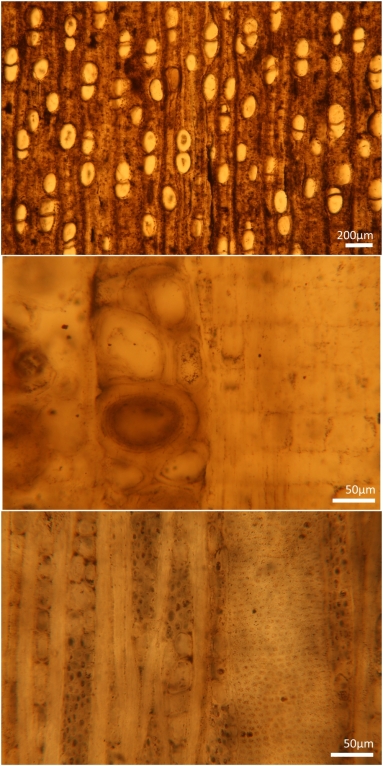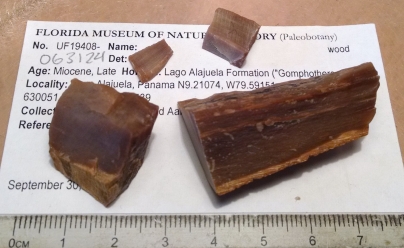Hello! My name is Carolyn Thornton and I’m a recent graduate from the College of Wooster in Ohio and a new museum intern in paleobotany. I’ve already had the opportunity to work on projects with fossil wood and leaves from Central America, as well as modern fruits from the family Chrysobalanaceae. A 19 million years old version of these fruits was described by Chris Nelson for a Fossil Friday a few weeks ago.
We’ve made the most headway with the fossil wood project. The wood was collected from the Miocene of Panama at Lago Alajuela and we’re working to describe them in enough detail that we can identify them and use their features to understand paleoclimate. So far we’ve definitively identified one wood to the family level.
I started with a particularly well-preserved piece of fossil wood (above) and cut it so that we had the three views necessary to completely describe it. The first view is a cross section, which allows us to see the distribution of vessels that run along the length of a tree, as well as the other tissues that run parallel to the vessels. The second is a radial section that should follow a ray somewhere along its path from the center of the tree outward. This shows us the cellular composition of the rays as well as longitudinal views of the vessels. The third view is a tangential section which is perpendicular to the rays and shows the height and width of the rays. Both the radial and tangential sections should be parallel to the length of the tree. Once I had these sections, I attached them to microscope slides with epoxy and ground them so that the fossil pieces were 30µm thick. This is thin enough that light can pass through and we can clearly see each feature.

Cross section, radial, and tangential surfaces. The dark vertical lines in the cross section are rays and the light, circular areas are vessels. The radial section shows a vessel containing tyloses. The tangential section shows a vessel with intervessel pits (right) and the rays with varying cell widths (left).
For the piece that we identified to family, some of the unique features that we used for identification (above) were the tyloses within the vessels, pitting in the vessels, and arrangement of cells in the rays (you can see that part of each ray is many cells wide while other parts are only one cell wide). Tyloses are growths that block the vessels and are grown in response to water stress. We put the features into the InsideWood database from North Carolina State University, which compares them to other woods that have been entered into the database and provides a list of possible matches. With the results of this search, as well as some help from Oris Rodriguez at the Smithsonian Tropical Research Institute, we determined that this wood is a member of the Elaeocarpaceae. Now we just have to do this a few dozen more times!

